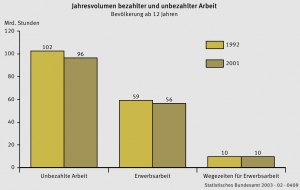 [English version]
[English version]
In unser wirtschaftsdominierten Gesellschaft gilt es als selbstverständlich, dass es im wesentlichen „die Wirtschaft“ sei, die die gesellschaftlich notwendigen Güter produziere. Dem ist jedoch nicht so. Durch einen Blick in die offiziellen Statistiken können wir uns davon eindrucksvoll überzeugen.
Das Statistische Bundesamt hat 1991/92 und 2001/02 jeweils eine Zeitbudgetstudie durchgeführt, in der ermittelt wurde, welche Zeit Menschen für welche Tätigkeit verwenden. Im Vorwort einer Broschüre zu den Ergebnissen der letzten Studie schreibt die seinerzeit zuständige Ministerin:
Dass zur Lebensqualität in unserer Gesellschaft gerade diejenigen Arbeiten gehören, die nicht bezahlt werden und somit nicht in die Volkswirtschaftlichen Gesamtrechnungen eingehen – also Arbeiten im Haushalt, die Kindererziehung, das bürgerschaftliche Engagement und Ehrenamt – das führt diese Untersuchung plastisch und unübersehbar vor Augen.
Bevor ich – im Gegensatz zur Ministerin, die mit dem zitierten Satz ihr Vorwort beendet – die Studie bewerten will, seien zunächst einmal einige Ergebnisse vorgestellt. Ich beschränke mich auf die Daten zur bezahlten und unbezahlten Arbeit. Als unbezahlte Arbeit gelten alle Tätigkeiten im Haushalt (die sog. Haushaltsproduktion), Pflege- und Betreuungs- sowie ehrenamtliche Tätigkeiten.
Die oben dargestellte Grafik (Klicken zum vergrößern) zeigt das Jahresvolumen der unbezahlten und bezahlten Arbeit jeweils für den Zeitraum der ersten und zweiten Studie. Berechnet man die jeweiligen Anteile an der insgesamt notwendigen Arbeit, so ergibt sich für beide Zeiträume ein Anteil von ca. 63% unbezahlter und 37% bezahlter Arbeit (mit minimaler Verschiebung in Richtung bezahlter Arbeit).
Die Wegezeiten zur Erwerbsarbeit wurden allerdings extra ausgewiesen. Rechnet man diese zur unbezahlten Arbeit (was in der Regel der Fall sein dürfte: obwohl für die Erwerbsarbeit erforderlich, gibt‘s dafür kein Geld), dann ergibt sich ein Anteil von ca. 65,5% unbezahlter und 34,5% bezahlter Arbeit. Insgesamt kann man also von einem Verhältnis von zwei Dritteln unbezahlter Arbeit und einem Drittel bezahlter Arbeit ausgehen.
Denkt man darüber hinaus an die Erkenntnis von Karl Marx, nach der sich der Wert der Ware Arbeitskraft durch die Kosten zu ihrer Wieder-/Herstellung bestimmt, dann wären die in der Studie separierten Bereiche der Regeneration (Freizeit, Erholung, Mediennutzung) und der Weiter-/Bildung ebenfalls mit einzubeziehen. Da es sich bei der Studie um eine Zeituntersuchung handelt, lassen sich jedoch insgesamt die monetären Kosten nicht bestimmen.
Auch die Betreuungszeiten bei pflegebedürftigen Personen sind eher unterschätzt, da „der ständige Bereitschaftsdienst“ (Schäfer) nicht mit berücksichtigt ist. Etc. Weitere Punkte ließen sich anführen, die jedoch immer mehr dazu führen, dass die Behandlung von Lebenstätigkeiten als „Arbeit“ generell fragwürdig wird und nicht nur die Tatsache, ob sie bezahlt sind oder nicht.
In der Studie wird dann lustiger Weise der Versuch unternommen, den „Wert“ der unbezahlten Arbeit auszurechnen. Angenommen wird eine Netto-Vergütung von 6 Euro (1991/92) bzw. 7 Euro (2001/02), rechnet man übliche Sozialleistungen hinzu, verdoppeln sich die Beträge. Ist man schon beim Rechnen, dann muss man auch die durchlaufenden vernutzten und die langlebigen Gebrauchsgüter einbeziehen. Am Ende landet man schließlich beim „Haushaltsunternehmen“, das man mit „normalen“ Wirtschaftsunternehmen vergleichen könne. Ihr Anteil am BIP (Bruttoinlandsprodukt) beträgt 43% bzw. 40%. Berechnungsbasis ist die o.g. Netto-Vergütung für das „Haushaltsunternehmen“. Setzt man hier Bruttolöhne oder etwa durchschnittliche Produktionslöhne ein, ergäben sich ganz andere Zahlen – womit die Zahlenspielerei auf Basis monetärer Werte generell witzlos wird.
Was bedeutet es, wenn doppelt so viele gesellschaftlich notwendige Tätigkeiten unbezahlt wie bezahlt erledigt werden?
Zunächst einmal sollte man sich die Tatsache klar machen, dass dem so ist. Die „Wirtschaft“ ist – zeitlich gesehen – nicht der wichtigste Bereich der gesellschaftlich-notwendigen Tätigkeiten. Gleichzeitig ist ihre Logik total dominant: Nur was sich rechnet, wird auch wirtschaftlich gemacht, sprich: verwertet. Keine Verwertung bedeutet Unglück, Armut, Ausgrenzung, Absturz.
Die „Nicht-Wirtschaft“ ist in doppelter Hinsicht die andere Seite der „Wirtschaft“: Ohne sie ginge „Wirtschaft“ nicht. Sie fängt all jene Tätigkeiten auf, die erledigt werden müssen, sich aber nicht verwerten lassen. Gleichzeitig ist sie Pool des potenziell „in Wert“ zu setzenden „Wertlosen“: Immer mehr Tätigkeiten werden von der Verwertungslogik erfasst und nach ihrem Bild formiert (vgl. die Pflegetätigkeiten, die nach Minuten skaliert werden, in der menschliche Zuwendung hingegen ein Fremdwort sein muss).
Es verwundert schließlich nicht, dass die beiden Bereiche geschlechtlich strukturiert sind (der Bereich der „Nicht-Wirtschaft“ wird in der Studie auf ihre Geschlechtsspezifik untersucht): Die „weibliche Nicht-Wirtschaft“ steht der „männlichen Wirtschaft“ gegenüber. Doch auch hier verhält es sich wie mit dem generellen Verhältnis von Verwertung und noch nicht Verwertetem: Was nicht ist, kann noch werden. Und andersherum: Wessen Arbeitskraft als nicht mehr verwertbar gilt, darf im abgespaltenen „Nicht-Bereich“ die physischen und psychischen Aufräumarbeiten erledigen.
Schon der Ökonom Friedrich List wusste:
Wer Schweine erzieht ist ein produktives, wer Kinder erzieht ein unproduktives Mitglied der Gesellschaft.
Exakt dort stehen wir heute noch.
Literatur
Bundesministerium für Familie, Senioren, Frauen und Jugend (Hrsg.), Wo bleibt die Zeit? Die Zeitverwendung der Bevölkerung in Deutschland 2001/02
D. Schäfer, Unbezahlte Arbeit und Haushaltsproduktion im Zeitvergleich, in: Statistisches Bundesamt (Hrsg.), Alltag in Deutschland. Analyse zur Zeitverwendung, Forum der Bundesstatistik, Band 43, 2004, S. 247-273.
Quellen online: Zeitbudgeterhebung
 Am 8. und 9. Oktober 2010 findet an der Freien Universität Berlin die dritte wissenschaftliche Konferenz über Freie Kultur statt. Titel der Konferenz: »Freie Kultur zwischen Commons und Märkten — Annäherung an eine hybride Ökonomie?« Die Teilnahme an der Konferenz ist kostenlos, eine Anmeldung ist jedoch erforderlich. Die Konferenzsprache ist englisch (=>Programm).
Am 8. und 9. Oktober 2010 findet an der Freien Universität Berlin die dritte wissenschaftliche Konferenz über Freie Kultur statt. Titel der Konferenz: »Freie Kultur zwischen Commons und Märkten — Annäherung an eine hybride Ökonomie?« Die Teilnahme an der Konferenz ist kostenlos, eine Anmeldung ist jedoch erforderlich. Die Konferenzsprache ist englisch (=>Programm).
